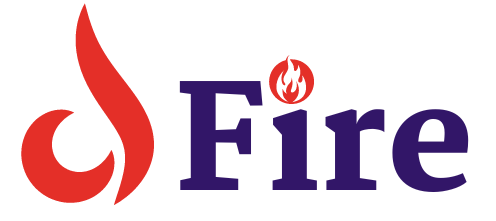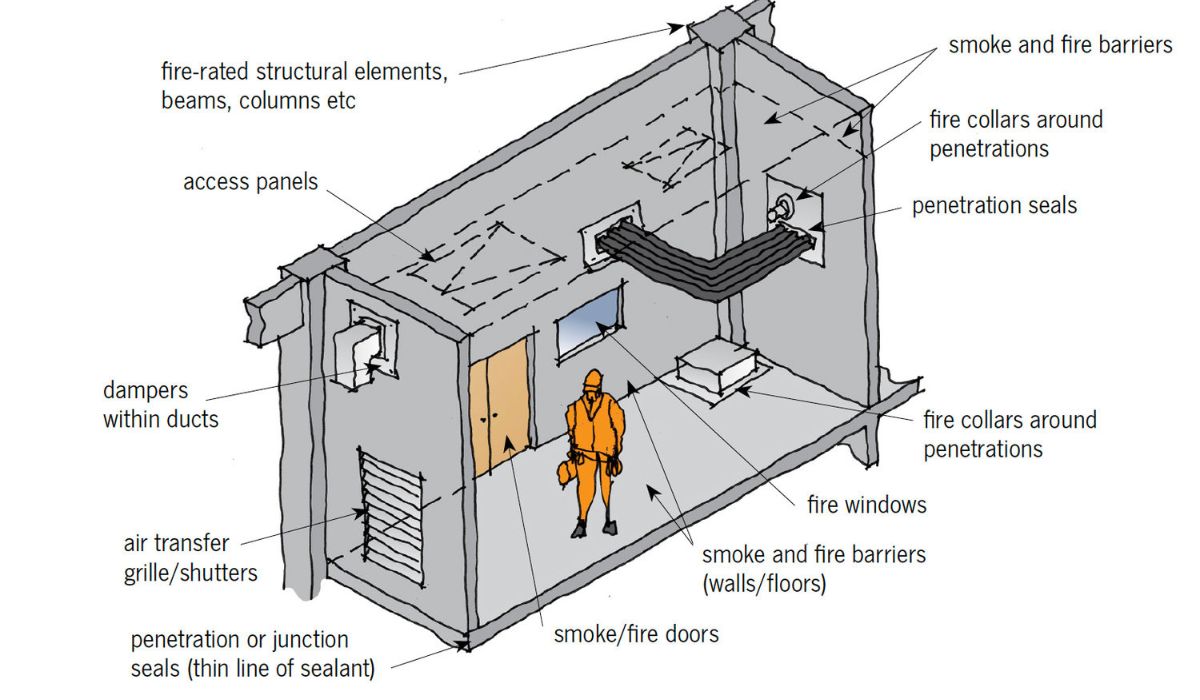Fire doors and fire-resistant wall and floor assemblies are examples of passive fire protection. Intumescent seals and firestops also play crucial roles.
Passive fire protection (PFP) systems are essential for the safety of any building structure. They provide a critical line of defense against the spread of fire, increasing the time available for evacuation and emergency response. These systems are built into the structure of a building and are designed to limit the spread of fire and smoke.
They do this by subdividing the building into compartments, thus containing the fire to its place of origin. This compartmentalization approach serves the dual purpose of protecting the structural integrity of the building and providing safe escape routes for occupants.
Unlike active fire protection systems, which require action to be effective, passive fire protection remains inert until needed, making it a reliable and low-maintenance option for fire safety. The integration of PFP in a building’s design is not just a regulatory requirement; it’s a fundamental aspect of a robust fire safety strategy.
The Critical Role Of Passive Fire Protection
Passive fire protection (PFP) stands as a building’s silent guardian. It’s a suite of safety measures designed to contain fires or slow their spread. Unlike active systems that require action, like sprinklers or alarms, passive fire protection is always at work. It can mean the difference between minor damage and total loss.
What Is Passive Fire Protection?
It’s an integral part of any building’s fire safety strategy. Materials and design features resist, contain, or slow the spread of fire and smoke. They remain inert until a fire occurs, activating to safeguard the structure.
- Fire-resistant walls, ceilings, and floors
- Fire doors that prevent flames from moving through a building
- Intumescent seals in doors and windows that expand to block fire paths
- Fire dampers in ductwork help contain smoke and flames
These components form barriers and protect the building’s integrity.
Why Passive Fire Protection Is Non-negotiable
The importance of PFP cannot be understated. Here’s why:
- Lives Saved: It provides crucial escape time during a fire.
- Property Protection: PFP limits fire damage to localized areas.
- Reduced Costs: Minimizes repair costs and business interruptions.
- Legal Compliance: Adheres to building codes and safety regulations.
It’s a fundamental aspect of construction that cannot be skipped or underrated. Ensuring PFP measures are in place is a key responsibility.
Material Matters: Fire-resistant Building Components
Buildings need strong materials to stay safe in a fire. Some materials can stop the fire or slow it down. They help people get out and keep the building standing. Let’s talk about two important fire-resistant materials.
Intumescent Paint And Coatings
Intumescent paint is like a superhero for buildings. When it gets hot, it puffs up and forms a protective layer that stops the fire from spreading. Here’s how it helps:
- Grows in size – It becomes much thicker when it gets hot.
- Protects – It keeps the flames away from what’s painted with it.
- Safe – It gives people more time to leave the building safely.
This paint is easy to use. You can put it on walls, doors, and even floors. And it’s not just safe; it also looks good.
Fire-resistant Glass And Walls
Fire-resistant glass is amazing. It can stop fire and smoke but still lets light through. It’s perfect for exits and windows. Fire-resistant walls are just as cool. They can stand against fire for hours. Here’s what makes them special:
| Type | Feature | Use |
| Fire-Resistant Glass | It Stops fire and smoke | Exits, Windows |
| Fire-Resistant Walls | Stands against fire | Building perimeters, Separation walls |
Compartmentalization: Containing The Uncontainable
In the realm of passive fire protection, compartmentalization plays a key role. It’s like a strategy game, where containing fire within a space can save the whole structure. This tactic involves dividing a building into smaller sections to slow the spread of flames and smoke. Let’s explore key features that make this possible.
Fire Doors And Firestops
Fire doors are the vigilant guards of fire safety. They stand as barriers in the face of fire, giving people time to escape and limiting smoke spread. These doors are designed to automatically close during a fire, creating a sealed area.
Firestops prevent fire from traveling across a building. Like filling in gaps in armor, they seal openings and joints in fire-resistance-rated wall and floor assemblies. Together, doors and stops are vital in controlling fire movement.
- Automatic closures in response to heat.
- Intumescent materials expand when hot, sealing gaps.
- Smoke seals hinder smoke from passing through door cracks.
Fire-rated Floors And Ceilings
Fire-rated floors and ceilings act as horizontal shields against fire. They are constructed with materials that withstand high temperatures for a specified time. By doing so, they provide a stable escape route and space for fire services to operate.
| Feature | Function | Fire-Resistance Rating |
| Reinforced concrete | Supports the structure | Up to 4 hours |
| Gypsum boards | Prevents spread upwards | 1 to 3 hours |
| Insulation | Slows heat transfer | Varies |
Fire Dampers And Seals: Breaching Invisible Barriers
Fire Dampers and Seals: Breaching Invisible Barriers serve as critical components in the safeguarding of buildings against the spread of fire and smoke. They sit hidden within walls, floors, and ductwork, poised to spring into action during a fire. Their role is to maintain the compartmentalization of a building, thereby delaying the spread of fire and providing occupants with precious time to evacuate. Understanding how these silent guardians function and their maintenance integrity ensures they remain vigilantly at the ready.
How Fire Dampers Function
Fire dampers are engineered to close automatically during high temperatures. They are typically installed in a building’s heating, ventilation, and air conditioning (HVAC) ducts. Upon detecting heat from a developing fire, the damper’s thermal element activates. This breaks, allowing the damper to shut via gravity or spring-powered action. This action seals off the duct, preventing fire and smoke from traveling through these potential pathways.
- Fuse links melt at predetermined temperatures.
- Spring-loaded dampers snap shut without delay.
- Some motorized dampers respond to smoke alarms or fire systems.
Integrity Of Fire And Smoke Seals
Fire and smoke seals are integral to the effectiveness of passive fire protection. Proper installation and regular inspections are paramount. Seals should adhere tightly to walls and gaps they are designed to protect, ensuring no cracks or openings. Over time, these seals can degrade. Regular checks and replacements are crucial for them to perform as expected.
| Location | Function | Check Frequency |
| Door Frames | Seal gaps during a fire | Every 6 months |
| Windows | Prevent smoke infiltration | Annually |
| Pipe Collars | Expand to seal around pipes | Every 6 months |
Structural Safeguards: Steel Protection Techniques
Buildings need strong bones. Just like our skeleton keeps us standing, steel gives buildings strength. But what if fire attacks? We have smart ways to protect steel. This post shares top methods for keeping steel tough against fire.
Fireproofing Of Structural Steel
Steel needs armor against fire. Fireproofing is like giving steel a shield. We wrap steel in special materials that resist heat. It can survive fierce fires and keep the building standing. Look at these cool fireproof tricks:
- Intumescent Paint: Paint that puffs up when hot, making a protective foam layer.
- Fireproof Cladding: Special panels attach to steel, stopping heat from getting through.
- Flexible Blankets: Wrap steel in blankets that can block heat. Simple and smart!
Concrete Encasement Strategies
Concrete is a hero for steel. It’s like steel wearing a concrete jacket. If fire comes, the concrete takes the heat. Here’s how we use concrete to guard steel:
| Method | Material |
| Poured Concrete | Strong liquid stone that hardens around steel. |
| Pre-Cast Blocks | Heavy stone blocks fit together around steel. |
| Concrete Boards | Solid boards screw to steel, easy and quick. |
Protective Insulation: A Barrier Against Flames
In the fight against fire, protective insulation is a silent guardian. Fire-resistant insulation not only slows fire spread but also gives people more time to evacuate safely. It acts as a shield, keeping the structure of a building intact and buying precious time for emergency response teams to take action.
Types Of Fire-resistant Insulation
Different materials offer varying levels of fire resistance. Here are key players in the insulation game:
- Fiberglass: Melts at high temperatures but is non-combustible.
- Mineral wool: Resistant to heat and fire, it’s a top choice for fire safety.
- Ceramic fiber: Provides excellent fire resistance and used in high-temperature areas.
- Cellulose: Treated with fire retardants, it’s effective and eco-friendly.
Insulation And Energy Efficiency
Fire-resistant insulation does more than protect against flames. It also helps keep your energy bills low. Proper insulation keeps heat out during summer and traps it during winter. It means your heating and cooling systems work less, saving energy and money. Check out these energy-efficient insulation materials:
| Insulation Material | Fire Resistance | Energy Efficiency |
| Fiberglass | Non-combustible | High |
| Mineral Wool | Excellent | High |
| Ceramic Fiber | Superior | Moderate to High |
| Cellulose | Good with Retardants | High |
Emergent Technologies In Passive Fire Protection
Emergent Technologies in Passive Fire Protection play a crucial role in enhancing building safety. These technologies aim to contain fires or slowdown their spread without human intervention. Staying ahead of fire hazards means integrating smart designs and novel materials into the infrastructure. Let’s delve into some groundbreaking advancements reshaping passive fire protection.
Smart Materials And Building Design
The realm of Smart Materials and Building Design has seen remarkable growth. Innovations focus on creating spaces that not only bear aesthetic appeal but also boast enhanced fire resilience.
- Fire-Responsive Materials: Developments in materials that expand or change when exposed to heat to seal off fire pathways.
- Intumescent Paints: These swells to form a protective barrier when heated, shielding the material beneath.
- Enhanced Insulation: Revolutionary insulating materials minimize heat transfer, enabling structures to withstand higher temperatures.
- Design Innovation: Architects now incorporate fire safety in initial designs by adding features like fire-resistant cores in panels and automated shutters.
Innovations In Fire-resistant Treatments
The landscape of Innovations in Fire-Resistant Treatments highlights the application of sophisticated fire-retardant chemicals and processes.
- Nano-coatings: Surface treatments that enhance fire resistance at a molecular level, protecting various substrates.
- Pressure-Treated Lumber: Wood infused with protective chemicals under high pressure for improved durability.
- Fire-Resistant Fabrics: Textiles treated to resist ignition and prevent flame spread, integral for curtains and upholstery in public spaces.
Technology Integration: The incorporation of sensors and alarms into treatments provides real-time fire alerts, increasing the window for safe evacuation.

I’m Abdus Sobur, a highly skilled and professional Fire Safety Officer with a passion for safeguarding lives and property. Over the course of my career, I’ve conducted numerous successful fire safety audits, earning a reputation for excellence in ensuring public safety.
In addition to my role as a Fire Safety Officer, I’m also dedicated to raising awareness about the importance of fire safety. Through my blog, I share insights into the functions of different fire safety equipment, aiming to empower individuals with the knowledge they need to protect themselves and their communities.
I’m driven by a deep commitment to promoting fire safety awareness and preventing fire-related incidents.

